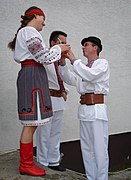National costumes of Poland
National costumes of Poland (Polish: stroje ludowe) vary by region. They are typically not worn in daily life but at folk festivals, folk weddings, religious holidays, harvest festivals and other special occasions.[1] The costumes may reflect region and sometimes social or marital status.[1]
Poland's inhabitants live in the following historic regions of the country: Greater Poland, Lesser Poland, Mazovia, Pomerania, Warmia, Masuria, Podlachia, Kuyavia and Silesia.
Lesser Poland / Małopolska
[edit]- Kraków region:[2] The woman's costume includes a white blouse, a vest that is embroidered and beaded on front and back, a floral full skirt, an apron, a red coral bead necklace, and lace-up boots. Unmarried women and girls may wear a flower wreath with ribbons while married women wear a white kerchief on their head. The men wear a blue waistcoat with embroidery and tassels, striped trousers, a krakuska cap ornamented with ribbons and peacock feathers and metal rings attached to the belt.
- Lachy Sądeckie live in southern Lesser Poland, especially in Nowy Sącz County and Kotlina Sądecka.
-
Western Kraków region
-
Eastern Kraków region
-
Kraków region
-
Lachy Sądeckie men's costume
-
Lachy Sądeckie, including married woman's costume
-
Lachy Sądeckie, including unmarried woman's costume
-
Lesser Poland
Gorals / Górale
[edit]Gorals live in southern Poland along the Carpathian Mountains, in Podhale of the Tatra Mountains and parts of the Beskids. Their costumes vary depending on the region.[3]
-
Żywiec
-
Podhale
-
Zakopane (1938)
-
Szczawnica (1939)
-
Gorals from Cieszyn Silesia
-
Tatra Gorals in 1877
-
Żywiec Gorals in 2016
-
Żywiec Gorals in traditional costume
-
Podhale Gorals in traditional costume
Subcarpathian region / Podkarpacie
[edit]-
Pogórzanie
-
Pogórzanie
-
Rzeszowiacy
-
Pogórzanie
-
Sanok (Kamraty)
-
Lasowiacy (Mazurians)
-
Rymanów (Pogórzanie)
-
Liszna (Sanok)
-
Lemkos from Przemyśl
Lublin region
[edit]-
Lublin region
-
Lublin
-
Biłgoraj
Silesia / Śląsk
[edit]- Bytom / Piekary Śląskie in Upper Silesia[7]
- Cieszyn Silesia, see
- Lower Silesia
-
Lower Silesia
-
Wilamowice, Vilamovians
Pomerania / Pomorze, Kujawy, Warmia
[edit]-
Kashubia
Masovia and central Poland
[edit]Places in Masovia with distinctive costumes include:
- Łowicz[12][13][14]
- Kurpie of the Green and White Primeval Forests[1][15][16]
- Wilanow
- Opoczno[17]
- Sieradz[18]
-
Kurpie
-
Central
-
Green Forest Kurpie
-
Green Forest Kurpie in 1913
Podlaskie / Podlasie
[edit]-
Podlasie
Greater Poland / Wielkopolska
[edit]Upper class
[edit]The szlachta were Polish nobles and had their own attire which included the kontusz, pas kontuszowy (sash) and a crimson żupan.[20]
-
Nobility
-
Bractwo Kurkowe (Kraków)
-
Bractwo Kurkowe (Kraków)
-
17th century
-
Żywiec
-
King Stanisław I in a Cracovian costume
Burghers
[edit]Mieszczanie were Polish burghers, among whom in 18th century czamaras gained a lot of popularity (especially in the Kraków region, hence the alternative name Kraków coat for czamara). In 19th century czamara became a Polish national and patriotic attire.[21]
-
Men in czamaras
-
Man wearing a czamara
See also
[edit]References
[edit]- ^ a b c "Polish Folk Costumes". The State Ethnographical Museum in Warsaw). Archived from the original on 2013-03-06. Retrieved 2012-05-20.
- ^ "opis stroju krakowskiego" [Description of Kraków folk costume] (in Polish). polalech.
- ^ Sieczka, Katarzyna. "Podhalański strój ludowy i jego wytwórcy u progu XXI w." [Podhale folk costume] (in Polish). z-ne.pl.
- ^ "STRÓJ RZESZOWSKI" [Rzeszów folk costume] (in Polish). Folklor Powiatu Debickiego.
- ^ "opis stroju lubelskiego" [Description of Lublin folk costume] (in Polish). polalech.
- ^ "Strój Biłgorajski" [Biłgoraj folk costume] (in Polish). Polska Tradycja.
- ^ "opis stroju bytomskiego" [Description of Bytom folk costume] (in Polish). polalech.
- ^ "Ubiór Kaszubski" [Kashubian attire] (in Polish). Kaszuby.vsp.pl.
- ^ "opis stroju kujawskiego" [Description of Kujawy folk costume] (in Polish). polalech.
- ^ "Strój Pyrzycki" [Pyrzyce folk costume] (in Polish). Pyrzyce Municipality. 2012-03-20.
- ^ "Strój Warmiński" [Warmia folk costume] (in Polish). Polska Tradycja.
- ^ "Strój łowicki" [Łowicz folk costume] (in Polish). Łowicz municipality. Archived from the original on 2013-03-18.
- ^ "Męski strój łowicki" [Łowicz men's folk costume] (in Polish). Łowicz municipality. Archived from the original on 2013-02-13.
- ^ "Kobiecy strój łowicki" [Łowicz women's folk costume] (in Polish). Łowicz municipality. Archived from the original on 2009-02-05.
- ^ "Strój Kurpiowski Puszczy Zielonej" [Green Forest Kurpie folk costume] (in Polish). Polska Tradycja.
- ^ "Strój Kurpiowski Puszczy Białej" [White Forest Kurpie folk costume] (in Polish). Polska Tradycja.
- ^ "Strój Opoczyński" [Opoczno folk costume] (in Polish). Polska Tradycja.
- ^ "Strój Sieradzki" [Sieradz folk costume] (in Polish). Polska Tradycja.
- ^ a b c "Stroje regionalne" [Regional costumes] (in Polish). Greater Poland region.
- ^ "opis stroju szlacheckiego" [Description of the costumes of the nobility] (in Polish). polalech.
- ^ Kubalska-Sulkiewicz, Krystyna; Bielska-Łach, Monika; Manteuffel-Szarota, Anna (1996). Słownik terminologiczny sztuk pięknych. Warszawa: Wydawnictwo Naukowe PWN. ISBN 83-01-11785-0.
External links
[edit]Media related to Traditional clothing of Poland at Wikimedia Commons





























































